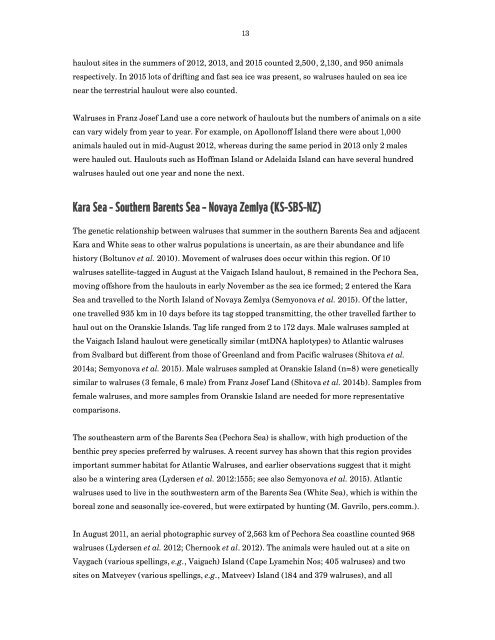The State of Circumpolar Walrus Populations
walrusreport
walrusreport
You also want an ePaper? Increase the reach of your titles
YUMPU automatically turns print PDFs into web optimized ePapers that Google loves.
13<br />
haulout sites in the summers <strong>of</strong> 2012, 2013, and 2015 counted 2,500, 2,130, and 950 animals<br />
respectively. In 2015 lots <strong>of</strong> drifting and fast sea ice was present, so walruses hauled on sea ice<br />
near the terrestrial haulout were also counted.<br />
<strong>Walrus</strong>es in Franz Josef Land use a core network <strong>of</strong> haulouts but the numbers <strong>of</strong> animals on a site<br />
can vary widely from year to year. For example, on Apollon<strong>of</strong>f Island there were about 1,000<br />
animals hauled out in mid-August 2012, whereas during the same period in 2013 only 2 males<br />
were hauled out. Haulouts such as H<strong>of</strong>fman Island or Adelaida Island can have several hundred<br />
walruses hauled out one year and none the next.<br />
Kara Sea - Southern Barents Sea – Novaya Zemlya (KS-SBS-NZ)<br />
<strong>The</strong> genetic relationship between walruses that summer in the southern Barents Sea and adjacent<br />
Kara and White seas to other walrus populations is uncertain, as are their abundance and life<br />
history (Boltunov et al. 2010). Movement <strong>of</strong> walruses does occur within this region. Of 10<br />
walruses satellite-tagged in August at the Vaigach Island haulout, 8 remained in the Pechora Sea,<br />
moving <strong>of</strong>fshore from the haulouts in early November as the sea ice formed; 2 entered the Kara<br />
Sea and travelled to the North Island <strong>of</strong> Novaya Zemlya (Semyonova et al. 2015). Of the latter,<br />
one travelled 935 km in 10 days before its tag stopped transmitting, the other travelled farther to<br />
haul out on the Oranskie Islands. Tag life ranged from 2 to 172 days. Male walruses sampled at<br />
the Vaigach Island haulout were genetically similar (mtDNA haplotypes) to Atlantic walruses<br />
from Svalbard but different from those <strong>of</strong> Greenland and from Pacific walruses (Shitova et al.<br />
2014a; Semyonova et al. 2015). Male walruses sampled at Oranskie Island (n=8) were genetically<br />
similar to walruses (3 female, 6 male) from Franz Josef Land (Shitova et al. 2014b). Samples from<br />
female walruses, and more samples from Oranskie Island are needed for more representative<br />
comparisons.<br />
<strong>The</strong> southeastern arm <strong>of</strong> the Barents Sea (Pechora Sea) is shallow, with high production <strong>of</strong> the<br />
benthic prey species preferred by walruses. A recent survey has shown that this region provides<br />
important summer habitat for Atlantic <strong>Walrus</strong>es, and earlier observations suggest that it might<br />
also be a wintering area (Lydersen et al. 2012:1555; see also Semyonova et al. 2015). Atlantic<br />
walruses used to live in the southwestern arm <strong>of</strong> the Barents Sea (White Sea), which is within the<br />
boreal zone and seasonally ice-covered, but were extirpated by hunting (M. Gavrilo, pers.comm.).<br />
In August 2011, an aerial photographic survey <strong>of</strong> 2,563 km <strong>of</strong> Pechora Sea coastline counted 968<br />
walruses (Lydersen et al. 2012; Chernook et al. 2012). <strong>The</strong> animals were hauled out at a site on<br />
Vaygach (various spellings, e.g., Vaigach) Island (Cape Lyamchin Nos; 405 walruses) and two<br />
sites on Matveyev (various spellings, e.g., Matveev) Island (184 and 379 walruses), and all


